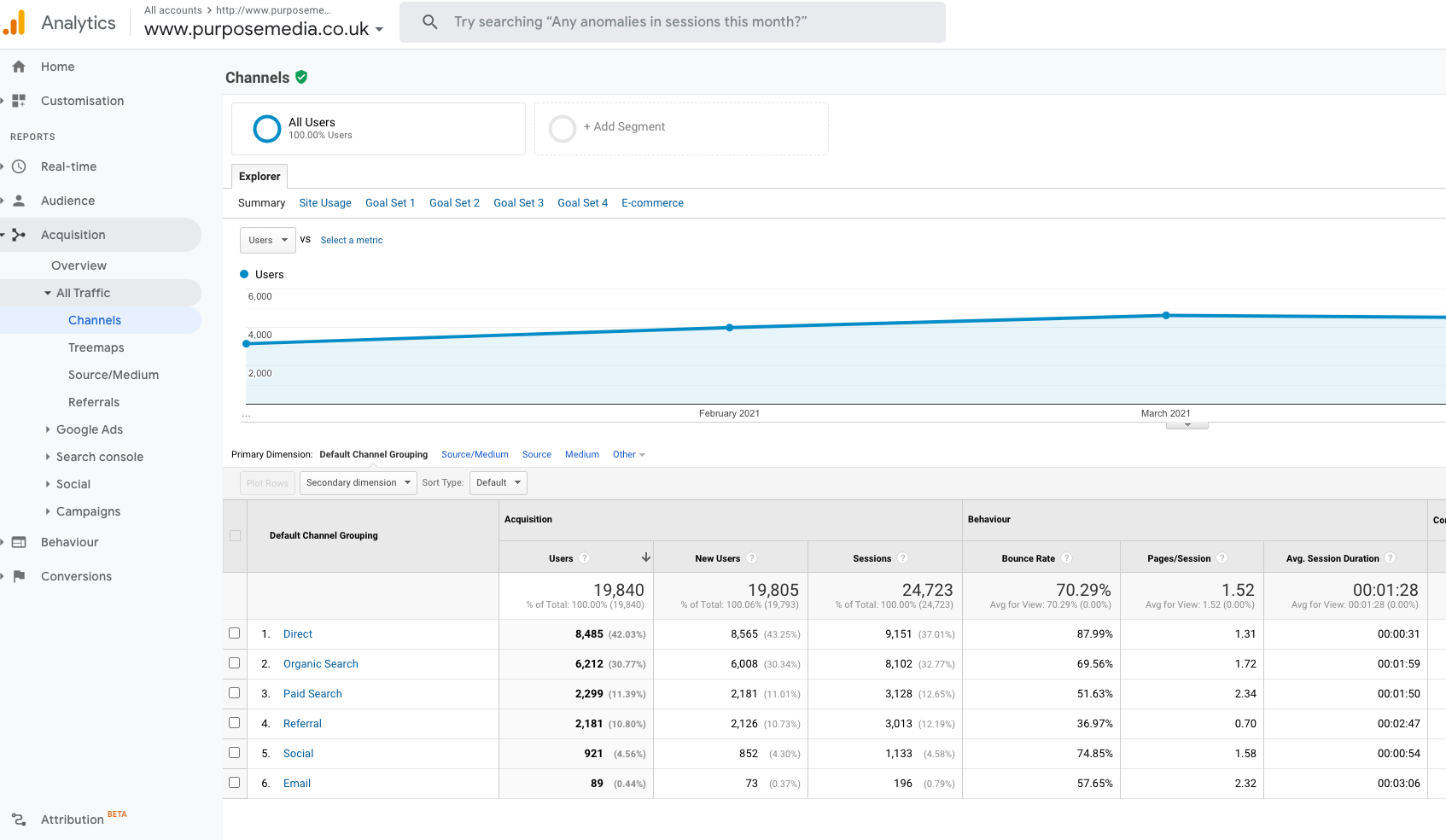Vanity metrics, the good, the bad and the ones to ignore.

In the world of digital marketing, we spend a large portion of our time looking at numbers.
However, it’s important to ensure you’re looking at, and measuring results against, the right numbers not just the ones that look good. If you’re more impressed by impressions than clicks, you may be suffering from metrics vanity.
In layman’s terms, a vanity metric is something that doesn’t produce much meaningful data – a result that may look good but doesn’t provide any real use to the outcome of your campaign.
These metrics are exciting to point to if you want to appear to be improving, but they often aren’t actionable and aren’t related to anything you can control or repeat in a meaningful way. Vanity metrics are most often contrasted against actionable metrics, which is data that helps you make decisions and helps your business reach its goals or grow.
The information that impressions provides is pretty low and are pretty useless without clicks or conversions.
For example, if your ad has been seen by 1500 people and only clicked by ten, then the ad obviously hasn’t worked out as well as you’d hoped. On the other hand, if your ad has 50 views and 45 clicks, your click through rate shows you that something about your ad is working.

An actionable metric is measurable and can be repeated. The difference between the two metrics is not always obvious, but for example, if you had 5000 social media followers, and you didn’t have a single conversion for three months, then you are left empty handed, with nothing but a vanity metric.
As marketers we have a use for each metric, and they can be interpreted in different ways – we could sit and argue for hours about which one is the most important. However, depending on what the business goals of your campaign are, each metric could be considered more important than the other…
So, let’s take closer look into which metric could be an actionable one and which ones are just fuelling your digital marketing ego.
Within PR there are plenty of metrics that can be considered vanity worthy. You can grow your audience to within the millions but if none of these followers turn into meaningful leads then they are pretty much useless to you and the value of your content is lost.
Of course, if your business goals are to be seen by a large audience, by all means do whatever is possible for you to grow your following. If you then want to convert your followers into regular customers of your brand, then you need to look for the small percentage of your following that are genuinely invested in your content.
Once a follower becomes a lead, they are much more useful to you. A few leads later and you have accumulated more than just a number on a screen, they become a collective that you can identify as the embodiment of your brand.
In the world of PPC it is a little easier to separate the two kinds of metrics, you can target your audience on social media and direct them straight to whichever page on your site that you deem will make them most likely to convert.
The focus of PCC is to get your ads in front of the right people at the right time and reflecting whether your campaign was a success or not is pretty simple.
For example, if your bounce rate is high, it can be a key performance indicator on where your ad has gone wrong. The landing page that you selected is obviously not what the user expected to see when they followed the link to your website.
Taken out of context, your campaign may look like a success when you only look at engagement alongside click through rate, however if your bounce rate is around 60-70% and conversion rate is below 15% then you are not guiding your customers to the end of their journey, you are giving them the key to the wrong door.
If you have high-level engagement resulting in a lot of page views with a low bounce rate and a low level of conversions, you need to take a closer look at why those customers are not completing the goal you have set out.
A PPCer’s best friend is probably Google Ads, setting a maximum spend and which keywords you want to focus your campaign around. The fact that you can set a limit on how much you want to spend on your ad can help you avoid vanity metrics and improve your businesses ROI.
You may end up having to spend £15 per conversion by ignoring the useful metrics and focusing on vanity metrics. Understanding the journey your customer is taking through your site is vital when it comes to converting them from a lead to a transaction, that is where Google Analytics can help you. We’ll cover that in more detail further on…
As the main goal of SEO is to improve organic ranking on Google it is easy to separate vanity metrics from actionable ones.
An actionable metric for SEO would be something along the lines of getting in the optimal number of keywords to help improve the rank of your website. On the other hand, a vanity metric, like PCC, can be the total number of pages visited. After all, a consumer can visit all the pages they like, if your site is not optimised then page visits cannot be considered a success.
If you want to help your company rank higher on Google, then you need to ignore all the vanity metrics in the world and focus on the data that can be replicated.
In SEO you should really measure success on the number you rank for on Google before and after the campaign.
Tools such as SEMrush can help you measure how useful certain keywords are to you, how many times they appear in the search bar each month and how difficult it will be to rank for them.
Pure vanity may be trying to make your website rank for Coca Cola when you sell shoes, people that are searching for Coca Cola are not interested in looking at shoes and it may then paint your brand in a bad light as your content is not related to your products.
Knowing which number to look at when dealing with social media metrics is tricky. Maybe it is how many views your Twitter account gets every day, or it might be how many visitors your company LinkedIn page has. Like every other vanity metric post views without engagement means nothing for your business.
Unless people actually like, comment on and share your posts, there is no point in measuring the impressions of your posts because your post can have over a million impressions, and without any engagement, those impressions don’t matter.
If your goal is to increase sales through social media, then how many likes a meme gets on Twitter is pointless and not really worth reporting. However, if your Twitter channel gains over five million new followers, you can use analytics you can see if they are coming to your website through a particular social channel.
Social media may be one of the hardest departments to block out vanity metrics as many of us will look at a post on LinkedIn that has over 15,000 views and think to ourselves that we have achieved something special.
That being said, you can celebrate the number of views on a YouTube video. Only because YouTube ranks the videos on its feed based on views. The only way to find out if your YouTube videos are useful to your business is by tracking, through analytics, the number of visitors that come to your website through YouTube, allowing you to see if the media channel can help you increase sales.
Raking higher on YouTube can also equate to more subscribers and in turn followers on other channels. If your main goal to increase exposure for your business, then definitely having a higher number of subscribers means your performance on YouTube can be considered a success.
The report on analytics allows you to see the number of users, subscribers or followers that come to your site through social media can show you if it means more leads and in turn increase sales and in turn increase revenue.

If you gain a lead from a social media post and one of your followers becomes a regular customer, then no social metrics cannot be compared to vanity metrics. The value of a single new customer can be huge for your brand, not the metric, new customer wont be replicated over and over, but in context the content has helped the growth of your business.
The number of followers your social media has can definitely be seen as actionable metrics opposed to vanity as it allows your posts to have the same number of impressions on every piece of content that you publish.
If those followers don’t turn into website visitors and you end up missing out on sales from elsewhere, you may have to review the tactics of your marketing campaign.
To be analytical is vital in any industry, particularly in marketing. Using the data that Google provides allows us to separate the vanity metrics from the actionable ones.
Sure, Google can’t tell you which number to look at, but it can provide vital information around marketing campaigns. The information analytics can give you about your site can also help to grow your business and make your website more accessible for your users.
Information such as bounce rate, traffic sources, goal completion and active users can provide you with a deeper understanding of your metrics.
Let’s explore these terms a little…
As already discussed, bounce rate can explain to you whether there is a problem with your ad or a problem with the page you have chosen to direct your targeted audience to. Bounce rate can normally be fixed by making changes to your website, it may be providing your users with a call to action, giving them more information on your product and how it can benefit them. Or even just rearranging the layout of your page.

Understanding how to track where your traffic is coming from can give a clear indication on how users are finding your business. It may be on social media; it might be from the LinkedIn retargeting ads that you set up last week. On the other hand, it can be just from straight up organic search on Google.
Knowing where your traffic comes from is key when looking at metrics, having a higher click through rate on Google may make you feel good, but having higher engagement and a higher number of conversions from social media will make you feel better. Sometimes having the data in front of you will help you ignore your own vanity and be more critical of the performance of your own marketing campaigns.
A goal completion can be anything from filling out a contact form on your website to having a £1500 conversion. It is easy to avoid making goal completions a vanity metric, however if you make a goal something simple such as clicking on an ad and reaching a landing page, the data will not be representative of how successful your campaign has been. Yes, you may have 5000 page views and therefore 5000 goal completions, but you might have 0 conversions.
Knowing when your users are active can be useful. Which page they are on and when shows you the journey your customers take but try not to fall into the trap of thinking more page views or active users your website has equates to better results.
Remember that actionable metrics are easy to repeat, it is not easy to constantly have active users on your website.
To learn more about analytics click here to check out our PPC experts guide to Google Analytics for beginners.
Vanity metrics can give all of us something to smile about. The only real way to know if they help is by tracking your followers through their journey, finding out what works and what doesn’t work. Only then can you say for certain what will help increase sales.
So, remember, track, measure and only focus on the right metric.
To find out more about vanity metrics and how you can measure your results more effectively, get in touch.